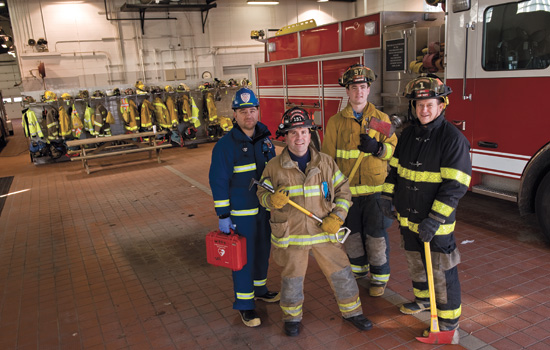Deaf firefighters answer call to serve
A. Sue Weisler
Tom Kuebler, left, Greg Doskos, Seth Terkhorn and David Hazelwood, all graduates from RIT/NTID, volunteer for Rochester-area fire departments.
Four RIT/NTID graduates share a unique passion and unique bond: They volunteer for local fire departments in the Rochester area.
No roster of deaf firefighters exists; the men estimate they are four of about 50 deaf firefighters nationwide.
“Although the Americans with Disabilities Act was signed more than 20 years ago, we’re still breaking down doors,” says David Hazelwood, a member of the Chili Volunteer Fire Department and a faculty member in the Arts and Imaging Studies department at NTID.
But not literally. Firefighting rules and department protocols prevent them from entering burning buildings, where they could become endangered in an environment that may be noisy and blinding with smoke. That current restriction is just fine with Hazelwood, who views his volunteer firefighting as community service.
“There’s enough other work that needs to be done,” he says. “I want to feel like I’m giving back.”
The men wear either hearing aids or cochlear implants to help them hear sounds. They also rely on lip reading, which can be difficult when others have masks on. They all have pagers to alert them—usually by vibration—to emergency calls. Seth Terkhorn sleeps with his under his pillow.
Terkhorn grew up on the Ohio/West Virginia border and became friends with a firefighter. In high school, he joined the Ironton (Ohio) Fire Department, where he became a captain. He opted to stay in Rochester after graduation due, in part, to the area’s large deaf population and deaf awareness.
“I like to help with the community,” he says. “And to prove that deaf people can be just as useful as hearing people.”
When he came to RIT/NTID, Terkhorn tried to join another local fire department, but that department denied his application because members said he couldn’t pass the physical due to his lack of hearing.
Neighboring West Brighton didn’t have an issue with it. He drives the department’s rescue truck and responds to house fires, helping set up hoses outside the structures. He can lip read well and has even been more of an asset when deaf patients have been involved in car accidents—he asked in sign language whether the victims were hurt.
Greg Doskos was a volunteer firefighter in his native Connecticut for 17 years. He became interested in firefighting from his two brothers, who were also in the fire department. When he moved to the Rochester area, he attempted to join the Mendon Fire Department. There was some initial resistance, but he was voted in 23 to 0 as an exterior firefighter and certified first responder.
He doesn’t drive the trucks due to a department rule that requires drivers to communicate via radio. But he responds to fires, helps operate the equipment on trucks and cleans up after house fires.
In 2009, Doskos was named firefighter of the year in his department. “Greg always takes the initiative to do something. He doesn’t wait around to be told to do it,” says Mendon Volunteer Fire Chief Jeff Singleton. “I wish I had 10 more of Greg.”
Singleton said Doskos started teaching sign language classes for others in the department, which has helped communication between Doskos and other firefighters.
Singleton said there might be a communication barrier between Doskos and other members, but it’s not insurmountable. “He understands. He truly understands what’s going on. He and I are constantly joking around,” he says.
Doskos has brought student sign language interpreters seeking real-world work experience with him for some training, business meetings or banquets. Other times, the department is billed for a professional interpreter. It’s an expense, Singleton says, that isn’t questioned.
Tom Kuebler volunteers as an emergency medical technician and responds to calls with the Hamlin Ambulance because he wants to give back to the community. Until recently, he was also a member of the Hamlin Volunteer Fire Department. He was fascinated with emergency responders from the time he was a child and watched Emergency! on television.
“Back in the 1990s, I tried to join the fire department in a Buffalo suburb but they flat turned me down,” Kuebler says. After moving to Hamlin in 2007, he joined the Hamlin Fire Department Auxiliary, got to know others in the department and eventually took the EMT test for his state certification.
He uses a special stethoscope that connects directly to his cochlear implant that allows him to hear heart and lung sounds.
“This enables me to take blood pressures and other vital signs in the field, a requirement by New York state,” he says.
He has a strobe light connected to his pager to wake him in the night in the event of an emergency call. Kuebler’s EMT instructor and others were concerned about whether a deaf person could even pass the EMT class to become certified. Other deaf applicants had struggled with the EMT class in the past.
“Not only did I do well on the state practical exam, I actually scored a 97 on the written exam. I think I surprised a lot of people,” Kuebler says. “It was hard work, a lot of hours of training, but it was worth it.”














